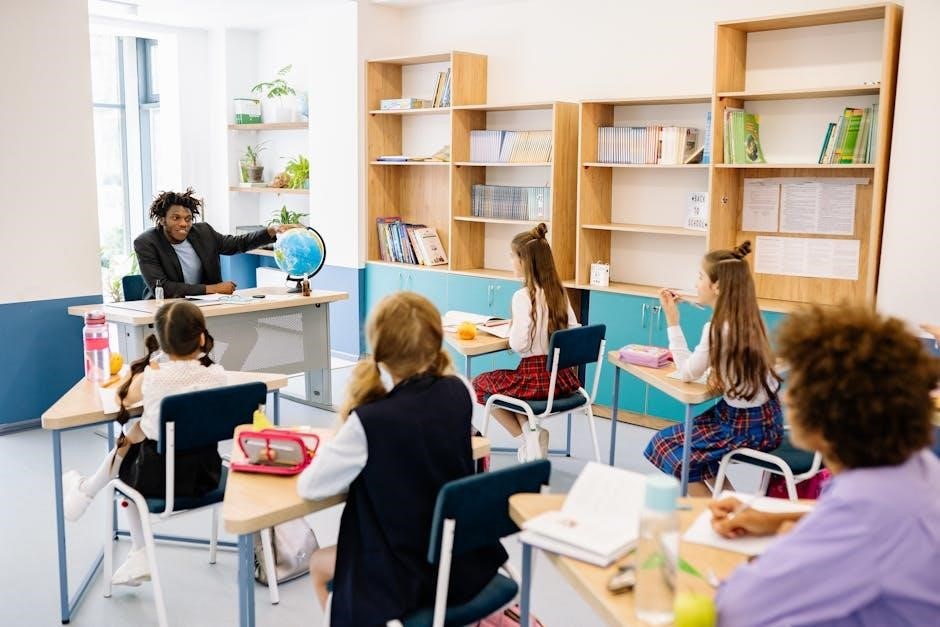The Sheltered Instruction Observation Protocol (SIOP) is a research-based framework designed to make grade-level content accessible and engaging for English Language Learners (ELLs). It emphasizes instructional strategies that promote language development and academic growth through structured, interactive lessons. A cornerstone of SIOP is instructional conversation, which involves guided discussions that foster students’ conceptual understanding and linguistic skills. This approach ensures equitable learning opportunities, making it a vital tool for educators in diverse classrooms.
1.1 Definition of SIOP (Sheltered Instruction Observation Protocol)
The Sheltered Instruction Observation Protocol (SIOP) is a research-based framework designed to make grade-level content accessible and engaging for English Language Learners (ELLs). It provides a structured approach to lesson planning and delivery, focusing on language development and academic growth. SIOP is not just a set of strategies but a comprehensive model that ensures equitable education by aligning instruction with the needs of linguistically diverse students. Its goal is to promote academic success through clear, scaffolded, and interactive instruction.
1.2 Overview of the SIOP Model
The SIOP Model is a comprehensive framework for teaching English Language Learners (ELLs) by integrating language and content instruction. It consists of eight key components: lesson preparation, building background, strategies, and scaffolding techniques. These components work together to ensure ELLs understand grade-level content while developing their language skills. The model emphasizes creating a supportive learning environment and fostering meaningful interactions, making it a powerful tool for promoting academic success and equity in diverse classrooms.
1.3 Importance of SIOP for English Language Learners (ELLs)
SIOP is crucial for English Language Learners (ELLs) as it provides equitable learning opportunities by making grade-level content accessible. The model bridges the gap between students’ language proficiency and academic demands, ensuring they can meet rigorous standards. By integrating language and content instruction, SIOP fosters engagement, conceptual understanding, and language development. It empowers ELLs to succeed academically while building confidence in their abilities, making it a vital tool for promoting equity and excellence in education.

Understanding Instructional Conversation in SIOP
Instructional conversation in SIOP is a discussion-based approach that goes beyond simple Q&A, fostering deeper understanding and language development through guided academic discourse.
2.1 Definition of Instructional Conversation
Instructional conversation in SIOP is a structured, discussion-based approach that encourages students to engage in meaningful academic dialogue. It involves guided discourse where students express their thoughts, opinions, and explanations on academic topics. This method goes beyond traditional question-and-answer exchanges, fostering both linguistic and conceptual growth. By promoting authentic communication, instructional conversation helps English learners develop their language skills while gaining a deeper understanding of content. It is a cornerstone of the SIOP model, ensuring equitable and engaging learning opportunities for all students.
2.2 Role of Instructional Conversation in the SIOP Framework
Instructional conversation plays a pivotal role in the SIOP framework by creating opportunities for English learners to engage in meaningful academic discussions. It serves as a bridge between language development and content understanding, ensuring that students can participate fully in grade-level lessons. By integrating language learning with content instruction, instructional conversation supports the development of both linguistic and conceptual skills. This approach is central to SIOP’s goal of making instruction accessible and engaging for all students, regardless of their language proficiency.
2.3 Key Characteristics of Instructional Conversation
Instructional conversation is characterized by its focus on discussion-based learning, where students engage in guided discourse about academic topics. It emphasizes student participation, allowing learners to express opinions, explain concepts, and negotiate meaning. These conversations are scaffolded by teachers to ensure accessibility and depth. Instructional conversation links language development with content learning, making it interactive and purposeful. It fosters critical thinking, collaboration, and authentic communication, while providing opportunities for linguistic growth and conceptual understanding. These elements make it a powerful tool for supporting English learners.

Components of Instructional Conversation
Instructional conversation includes student-led discussions, teacher facilitation strategies, and opportunities for student talk. These components work together to create engaging, interactive, and meaningful learning experiences.
3.1 Student-Led Discussions
Student-led discussions are a key component of instructional conversation, allowing learners to take an active role in exploring academic topics. These discussions enable students to express their thoughts, opinions, and explanations, fostering deeper understanding and language development. By shifting the responsibility of conversation from teacher to students, educators create opportunities for authentic communication and critical thinking. This approach empowers English Language Learners to engage meaningfully with content while developing essential communication skills.
3.2 Teacher Facilitation Strategies
Teacher facilitation strategies in SIOP involve guiding and scaffolding instructional conversations to ensure student understanding and participation. Educators use open-ended questions, prompts, and clarifications to encourage deeper thinking. They also provide linguistic support, such as modeling academic language and offering feedback. These strategies create a structured yet supportive environment, allowing students to connect their experiences with new content. Effective facilitation ensures equitable engagement, fostering both language development and conceptual understanding among English Language Learners.
3.3 Opportunities for Student Talk
Opportunities for student talk in SIOP are essential for fostering language development and critical thinking. Educators create structured moments for students to express ideas, engage in discussions, and use academic language. These opportunities include pair-share activities, small-group discussions, and whole-class conversations. Scaffolding techniques ensure students are prepared to participate meaningfully. Teachers also allocate time for students to articulate their thoughts, promoting equitable participation and deeper understanding of content. This emphasis on student voice enhances engagement and supports linguistic growth.

Benefits of Instructional Conversation
Instructional conversation in SIOP enhances academic language skills, fosters critical thinking, and increases student engagement, providing meaningful opportunities for linguistic and cognitive growth.
4.1 Development of Academic Language Skills
Instructional conversation in SIOP plays a pivotal role in developing students’ academic language skills by engaging them in meaningful discussions. Through scaffolded interactions, students are encouraged to articulate their thoughts, use complex vocabulary, and construct coherent sentences. This fosters a deeper understanding of academic concepts while building proficiency in English. By participating in guided conversations, learners gain confidence in expressing themselves, aligning their language use with content objectives and fostering overall linguistic growth.
4.2 Enhancement of Critical Thinking
Instructional conversation in SIOP enhances critical thinking by engaging students in meaningful discussions that require analysis, interpretation, and problem-solving. Through open-ended questions and collaborative dialogue, students are prompted to share opinions, justify reasoning, and explore multiple perspectives. These interactions encourage deeper conceptual understanding and the ability to connect ideas logically. By fostering an environment where students articulate their thoughts and defend their positions, instructional conversations strengthen their capacity for critical thinking and prepare them for complex academic challenges.
4.3 Increased Student Engagement
Instructional conversation significantly boosts student engagement by creating interactive and dynamic learning environments. When students are encouraged to express their thoughts and participate in discussions, they feel valued and motivated. This active involvement fosters a sense of ownership over their learning, leading to higher levels of participation and focus. Engaging in meaningful conversations also helps students connect with the material personally, making lessons more relevant and interesting, which in turn enhances their overall engagement and academic performance. This approach ensures that all learners are actively involved.

Implementation Strategies for Instructional Conversation
Effective implementation involves planning engaging discussions, creating a supportive environment, and using scaffolding techniques to ensure students actively participate and develop linguistic and critical thinking skills.
5.1 Planning Lesson Objectives
Planning lesson objectives is crucial for effective instructional conversation. Teachers must clearly define content and language goals, ensuring they align with students’ needs and standards. This involves identifying key concepts and skills, such as academic vocabulary or critical thinking, and structuring discussions to target these areas. By setting specific, measurable objectives, educators create a roadmap for student learning, fostering purposeful conversations that enhance both language proficiency and subject matter understanding. This step ensures focused and productive instructional dialogue.
5.2 Building Background Knowledge
Building background knowledge is essential for fostering meaningful instructional conversations. Teachers use strategies like visual aids, graphic organizers, and connections to students’ prior learning to create a shared understanding of key concepts. This step ensures that English learners can engage in discussions about academic topics, even if they lack prior exposure. By bridging gaps in knowledge, educators scaffold students’ ability to participate fully, enhancing both language development and content comprehension. This foundational step is vital for productive and inclusive classroom dialogues.

5.3 Scaffolding Techniques
Scaffolding techniques in SIOP involve providing temporary support to students as they engage in instructional conversations. Teachers use strategies like visual aids, graphic organizers, and sentence frames to guide students in articulating their thoughts. This support helps bridge language gaps and builds confidence, enabling students to participate meaningfully. By gradually releasing responsibility, educators help students develop linguistic and conceptual skills independently. Scaffolding ensures that all learners, especially ELLs, can access and succeed in academic discussions, fostering both language development and content understanding effectively.

Assessing Instructional Conversation
Assessing instructional conversation involves monitoring student participation, evaluating language development, and adjusting strategies to ensure learners meet content and language objectives effectively.
6.1 Monitoring Student Participation
Monitoring student participation in instructional conversations ensures all learners engage actively. Teachers observe verbal contributions, body language, and interactions to identify those needing extra support. This helps maintain equity and encourages authentic communication, fostering an inclusive environment where every student feels valued. Regular monitoring allows educators to adjust facilitation strategies, ensuring diverse learners participate meaningfully and achieve lesson objectives effectively. This proactive approach supports language development and academic success for all students.
6.2 Evaluating Language Development
Evaluating language development in instructional conversations involves assessing students’ ability to express ideas clearly and use academic language effectively. Teachers listen for improvements in vocabulary, grammar, and communication skills. This evaluation helps identify progress toward language objectives and informs future instruction. By regularly assessing language growth, educators can refine their strategies to better support English learners, ensuring they meet both content and language goals. This step is crucial for fostering continuous improvement in students’ linguistic abilities.
6.3 Adjusting Instructional Strategies
Adjusting instructional strategies ensures that teaching methods align with student needs, particularly for ELLs. Teachers reflect on assessment data to refine their approaches, such as modifying scaffolding techniques or incorporating more opportunities for student talk. By making these adjustments, educators enhance the effectiveness of instructional conversations, fostering deeper understanding and engagement. This iterative process ensures that lessons remain relevant and supportive, ultimately promoting academic and language growth for all learners. Continuous adaptation is key to meeting diverse student needs.

Connection to Other SIOP Components
Instructional conversation aligns with SIOP components like lesson preparation, building background, and content/language objectives, ensuring a cohesive and integrated approach to teaching ELLs effectively.
7.1 Integration with Lesson Preparation
Instructional conversation is deeply integrated with SIOP’s lesson preparation, ensuring that content and language objectives guide meaningful discussions. Teachers design lessons with specific academic topics in mind, creating opportunities for students to engage in guided discourse. This alignment ensures that instructional conversations are purposeful, fostering both conceptual understanding and linguistic growth. By connecting preparation to conversation, educators create a cohesive learning environment that supports English Language Learners’ needs effectively. This integration enhances the overall instructional framework, making lessons more accessible and engaging for all students.
7.2 Link to Building Background
Instructional conversation is closely tied to building background knowledge, as it provides opportunities for students to connect new information with their prior experiences. Through guided discussions, teachers help students activate schema, making academic content more accessible. This link ensures that English Language Learners (ELLs) can engage meaningfully with lessons, even when their background knowledge may be limited. By scaffolding understanding through conversation, educators create a bridge between students’ existing knowledge and new concepts, fostering both language development and content comprehension.
7.3 Relationship with Content and Language Objectives
Instructional conversation aligns closely with both content and language objectives in SIOP. It provides opportunities for students to engage with academic material while practicing language skills. By linking discussions to specific learning goals, teachers ensure that students develop both conceptual understanding and linguistic proficiency. This integration allows English Language Learners (ELLs) to simultaneously master grade-level content and improve their language abilities, making instructional conversation a powerful tool for achieving SIOP’s dual focus on content and language learning.

Challenges and Solutions
Managing classroom dynamics, ensuring equitable participation, and addressing linguistic diversity are challenges. Solutions include professional development, strategic facilitation, and culturally responsive teaching strategies.
8.1 Managing Classroom Dynamics
Managing classroom dynamics during instructional conversations can be challenging, especially in diverse classrooms. Teachers must balance student participation, maintain focus, and ensure respectful dialogue. Strategies like setting clear expectations, using non-verbal cues, and encouraging active listening help create a structured environment. Additionally, teachers should be prepared to adapt conversations to meet students’ needs, ensuring equitable participation and preventing side conversations. Effective management fosters engagement and promotes meaningful academic discussions, particularly for English Language Learners (ELLs).
8.2 Ensuring Equitable Participation
Ensuring equitable participation in instructional conversations is crucial for fostering inclusivity and engagement. Teachers can create an environment where all students, including ELLs, feel valued and encouraged to contribute. Strategies include prompting all students to share their thoughts, using visual aids to support understanding, and providing scaffolding techniques to help students articulate their ideas. By actively monitoring participation and addressing language barriers, educators can ensure that every student has opportunities to engage meaningfully in academic discussions. This promotes a sense of belonging and enhances language development.
8.3 Addressing Linguistic and Cultural Diversity
Addressing linguistic and cultural diversity in instructional conversations is essential for creating inclusive learning environments. Teachers must recognize and respect students’ diverse backgrounds, incorporating culturally relevant topics and examples. Scaffolding techniques, such as visual aids and sentence frames, can help bridge language gaps. Additionally, encouraging students to share their cultural perspectives fosters a sense of belonging and enriches classroom discussions. By acknowledging and valuing diversity, educators can ensure all students, regardless of linguistic or cultural background, participate fully and benefit from instructional conversations.

Best Practices for Effective Instructional Conversation
Best practices include fostering a supportive environment, encouraging authentic communication, and providing constructive feedback. Teachers should promote engagement, scaffold discussions, and integrate cultural responsiveness to meet diverse needs.
9.1 Creating a Supportive Learning Environment
Creating a supportive learning environment is crucial for effective instructional conversation. Teachers should foster an atmosphere of respect, inclusivity, and safety, allowing students to express their thoughts without fear of judgment. This encourages active participation and authentic communication. By integrating students’ backgrounds and experiences, educators can make content more relatable and engaging. Establishing clear expectations and encouraging collaboration also helps build trust and promotes meaningful dialogue, essential for academic and language development.
9.2 Encouraging Authentic Communication
Encouraging authentic communication is vital for effective instructional conversation. Teachers should create opportunities for students to engage in meaningful discussions, sharing their opinions and perspectives. This fosters a deeper understanding of academic content while developing language skills. By using open-ended questions and promoting small-group discussions, educators can encourage genuine interactions. Providing constructive feedback and creating a judgment-free environment further supports authentic communication, helping students feel confident in expressing their thoughts and ideas. This approach enhances both language proficiency and critical thinking abilities;
9.3 Providing Feedback and Guidance
Providing feedback and guidance is essential for improving students’ language and conceptual skills during instructional conversations. Teachers should offer constructive, specific feedback that helps students refine their ideas and language use. Scaffolding techniques, such as modeling and prompting, guide students in expressing their thoughts more effectively. Feedback should be timely and nonjudgmental, fostering a growth mindset. By clarifying misunderstandings and encouraging reflection, educators help students build confidence and improve their ability to communicate academically. This support enhances both language development and critical thinking.
